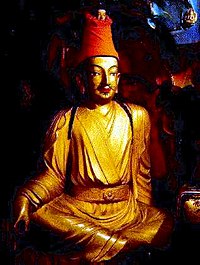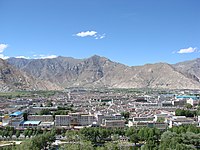ലാസ
Lhasa 拉萨 • ལྷ་ས། Chengguan | |
|---|---|
District | |
| 城关区 • ཁྲིན་ཀོན་ཆུས | |
 From upper left: roof of the Jokhang Temple; Norbulingka monastery main gate; Potala Palace; Wheel of Dharma and prayer wheels (bottom), Jokhang; satellite picture of Lhasa | |
 Chengguan District (pink) within Lhasa (yellow) | |
| Country | |
| Region | Tibet Autonomous Region |
| Prefecture-level city | Lhasa |
| • Mayor (of prefecture-level city) | Zhang Tingqing |
| • Deputy mayor (of prefecture-level city) | Jigme Namgyal |
| • District | 525 ച.കി.മീ.(203 ച മൈ) |
| • നഗരം | 60 ച.കി.മീ.(20 ച മൈ) |
| ഉയരം | 3,656 മീ(11,995 അടി) |
(2000) | |
| • District | 2,23,001 |
| • ജനസാന്ദ്രത | 424.8/ച.കി.മീ.(1,100/ച മൈ) |
| • Major Nationalities | Tibetan; Han; Hui |
| • Languages | Tibetan, Mandarin, Jin language (Hohhot dialect) |
| സമയമേഖല | UTC+8 (China Standard) |
| Postal code | 850000 |
| ഏരിയ കോഡ് | 891 |
| വെബ്സൈറ്റ് | www |
| ലാസ | |||||||||||||||||||
 "Lhasa" in Simplified Chinese (top), Traditional Chinese (middle), and Tibetan (bottom) | |||||||||||||||||||
| Chinese name | |||||||||||||||||||
|---|---|---|---|---|---|---|---|---|---|---|---|---|---|---|---|---|---|---|---|
| Simplified Chinese | 拉萨 | ||||||||||||||||||
| Traditional Chinese | 拉薩 | ||||||||||||||||||
| Literal meaning | (Tibetan) "Place of the Gods" | ||||||||||||||||||
| |||||||||||||||||||
| Chengguan District (main urban area) | |||||||||||||||||||
| Simplified Chinese | 城关区 | ||||||||||||||||||
| Traditional Chinese | 城關區 | ||||||||||||||||||
| |||||||||||||||||||
| Also known as | |||||||||||||||||||
| Simplified Chinese | 逻些 | ||||||||||||||||||
| Traditional Chinese | 邏些 | ||||||||||||||||||
| |||||||||||||||||||
| Tibetan name | |||||||||||||||||||
| Tibetan | ལྷ་ས་ | ||||||||||||||||||
| |||||||||||||||||||
ചൈനയിലെ തിബെത്തിന്റെ തലസ്ഥാനമാണ് ലാസ(Lhasa).[1] ടിബറ്റൻ പീഠഭൂമിയിലെ ഏറ്റവും അധികം ജനസംഖ്യയുള്ള രണ്ടാമത്തെ നഗരമാണ് ലാസ. സമുദ്രനിരപ്പിൽനിന്നും 3,490 metres (11,450 ft) ഉയരത്തിൽ സ്ഥിതിചെയ്യുന്ന ഈ നഗരം ലോകത്തിൽ ഏറ്റവും ഉയരത്തിൽ സ്ഥിതിചെയ്യുന്ന നഗരങ്ങളിൽ ഒന്നാണ്. പതിനേഴാം ശതകത്തിന്റെ മദ്ധ്യകാലം മുതൽ തിബെത്തിന്റെ തലസ്ഥാനവും ടിബെറ്റൻ ബുദ്ധമതത്തിന്റെ സാംസ്കാരിക പ്രധാന്യമുള്ള കേന്ദ്രങ്ങളിൽ ഒന്നുമാണ്.
പേരിനു പിന്നിൽ
[തിരുത്തുക]ദൈവങ്ങളുടെ സ്ഥാനം എന്നാണ് ലാസ എന്ന വാക്കിന്റെ അർഥം. പുരാതന തിബെത്തൻ രേഖകളിൽ രാസ എന്നും രേഖപ്പെടുത്തിക്കാണാറുണ്ട്. [2]
ചരിത്രം
[തിരുത്തുക]
ഏഴാം നൂറ്റാണ്ടോടെ സോങ്ത്സെൻ ഗമ്പോ യാർലങ് റ്റ്സാങൊ എന്ന് പ്രാദേശികമായി വിളിക്കപ്പെടുന്ന ബ്രഹ്മപുത്രാ തടത്തിലെ തിബെത്തൻ സാമ്രാജ്യത്തിന്റെ പ്രധാന നേതാവായിത്തീർന്നു,[3] ഷാങ്ഷുങ്(Zhangzhung) എന്ന പടിഞ്ഞാറൻ രാജ്യം കീഴടക്കിയതിനുശേഷം 637-ൽ തന്റെ തലസ്ഥാനം റ്റക്റ്റ്സെ കൊട്ടാരത്തിൽനിന്നും യാർലങ് താഴ്വരയിലെ രാസയിലേക്ക് മാറ്റി(ലാസ), ഇന്ന് മരോപി മലയിൽ (Mount Marpori) പോടാല കൊട്ടാരം സ്ഥിതിചെയ്യുന്ന പ്രദേശത്ത് കെട്ടിടങ്ങൾ നിർമ്മിച്ചു.[4] 641 ആയപ്പോഴേക്കും ടിബറ്റൻ പ്രദേശം മുഴുവൻ കീഴടക്കിയ സോങ്ത്സെൻ ഗാമ്പൊ ആദ്യം നേപ്പാളിലെ ഭ്രികുതി(Bhrikuti) രാജകുമാരിയെയും [5] രണ്ട് വർഷത്തിനുശേഷം ടാങ് രാജവംശത്തിലെ വെഞ്ചെങ് രാജകുമാരിയെയും വിവാഹം കഴിച്ചു. ഭ്രികുതി രാജകുമാരിയാണ് സോങ്സ്റ്റൺ ഗാമ്പൊയെ ബുദ്ധമതാനുയായിയാക്കിയതെന്ന് കരുതപ്പെടുന്നു, 641ൽ അദ്ദേഹം ജൊഖാങ്, രാമൊചെ എന്നി ക്ഷേത്രങ്ങൾ നിർമ്മിച്ച് ഈ രാജകുമാരികൾ നൽകിയ അക്ഷോഭ്യ വജ്ര (ബുദ്ധന്റെ എട്ടാം വയസ്), ജോവൊ സഖ്യമുനി (ബുദ്ധന്റെ പന്ത്രണ്ടാം വയസ്) പ്രതിമകൾ പ്രതിഷ്ഠിച്ചു[6][7] പിന്നീട് ഒൻപതാം നൂറ്റാണ്ടിൽ ബോൺ മതവിശ്വാസിയായ ലാങ്ധർമന്റെ കാലഘട്ടത്തിൽ ലാസയിലെ ക്ഷേത്രങ്ങൾ തകർക്കപ്പെട്ടു[8]
സോങ്സ്റ്റൺ ഗാമ്പൊയുടെ കാലശേഷം ചൈനീസ് സൈന്യം ലാഹ കീഴടക്കി ചുവന്ന കൊട്ടാരം തകർത്തുവെന്നാണ് ടിബെറ്റൻ വിശ്വാസം[9][10] എന്നാൽ ചൈനീസ് പണ്ഡിതർ ഇതിന് തെളിവുകൾ ഇല്ലെന്നാണ് അഭിപ്രായപ്പെടുന്നത് .[11] പിന്നീട് ഒൻപതാം നൂറ്റാണ്ടിൽ അഞ്ചാമത്തെ ദലൈ ലാമ പദവി ഏറ്റെടുക്കുന്നതുവരെ ടിബറ്റൻ പ്രദേശത്തിന്റെ പ്രധാന രാഷ്ട്രീയകേന്ദ്രം ലാസ ആയിരുന്നുല്ലെങ്കിലും മതകേന്ദ്രമെന്ന നിലയിൽ ലാസയുടെ പ്രധാന്യം വർദ്ധിച്ചുവന്നു .[12]
പദ്മസംഭവ ജോഖാങ് ക്ഷേത്രത്തിന്റെ നിർമ്മാണത്തിന് തുടക്കം കുറിച്ചതിനും, ഭൂമിയിലെ ദുഷ്ടശക്തികളെ കീഴടക്കിയതെന്ന ഐതിഹ്യവും ലാസയെ തിബെത്തിന്റെ കേന്ദ്രമായി കരുതപ്പെടാനിടയാക്കി.[13] 11-ആം നൂറ്റാണ്ടുമുതൽ ഇവിടെ ഇസ്ലാം മതവും പ്രചാരത്തിലുണ്ടായിരുന്നു.[14]
പതിനഞ്ചാം നൂറ്റാണ്ടിൽ ജെ റ്റ്സോങ്കപ മൂന്ന് ഗെലുഗ്പ ബുദ്ധമതവിഹാരങ്ങൾ സ്ഥാപിച്ചതോടെ ലാസ വീണ്ടും ഒരു പ്രധാന ബുദ്ധമതകേന്ദ്രമായി. ഗെൻഡേൻ, സെറ, ഡ്രേപെങ് എന്നിവയാണ് തിബെതിലെ ബുദ്ധമതോഥാനത്തിന്റെ ഭാഗമായി നിർമ്മിക്കപ്പെട്ട ബുദ്ധമതവിഹാരങ്ങൾ.[15] അഞ്ചാമത്തെ ദലൈ ലാമയായ ലോബ്സാങ് ഗ്യാറ്റ്സോ (1617–1682) തിബെതിനെ ഏകീകരിക്കുകയും 1642-ൽ ഖോഷട്ടിലെ ഗുഷി ഖാന്റെ സഹായത്തോടെ ഭരണകേന്ദ്രം ലാസയിലേക്കു മാറ്റുകയും ചെയ്തു.
1987–1989 കാലത്തിൽ ബുദ്ധ സന്യാസിമാരുടേയും സന്യാസിനിമാരുടെയും നേതൃത്വത്തിൽ ചൈനീസ് ഗവണ്മെന്റിനെതിരായ പ്രക്ഷോഭങ്ങൾ നടന്നു. 1992-ലെ ഡേങ് ക്സിയായൊപെങിന്റെ സന്ദർശനത്തിനുശേഷം ഗവണ്മെന്റ് ലാസയിൽ സാമ്പത്തികപരിഷ്കാരങ്ങൾ നടപ്പിലാക്കി, കൂടാതെ എല്ലാ ഗവണ്മെന്റ് ജീവനക്കാരും അവരുടെ കുടുംബാംഗങ്ങളും വിദ്യാർഥികളും ബുദ്ധമതാചാരങ്ങൾ പിന്തുടരരുതെന്നും സന്യാസികൾ ഗവണ്മെന്റ് ഓഫീസുകളിലോ തിബെത് യൂണിവേഴ്സിറ്റിയിലോ പ്രവേശിക്കരുതെന്നും ഗവണ്മെന്റ് നിർദ്ദേശിച്ചു.
2000-മാണ്ടോടെ ലാസയിലെ 53 square kilometres (20 sq mi) പ്രദേശം നഗരവൽക്കരിക്കപ്പെട്ടിട്ടുണ്ട്, ജനസംഖ്യയായ 170,000 ഔദ്യോഗിക കണക്കുകൾ പ്രകാരം 34.3% ഹാൻ വംശജരും 2.7% ഹൂയി വംശജരും ബാക്കി തിബത്തൻ വംശജരുമാണ്, എന്നാൽ തിബത്തൻ വംശജരല്ലാത്തവരുടെ എണ്ണം അൻപത് ശതമാനത്തിനും എഴുപത് ശതമാനത്തിനും ഇടയിലാണെന്നാണ് ചില നിരീക്ഷകരുടെ അഭിപ്രായം.
ഭൂമിശാസ്ത്രം
[തിരുത്തുക]സമുദ്രനിരപ്പിൽനിന്നും ഏകദേശം 3,600 m (11,800 ft)[16] ഉയരത്തിൽ തിബെത്തൻ പീഠഭൂമിയുടെ മദ്ധ്യഭാഗത്തായി സ്ഥിതി ചെയ്യുന്ന ലാസയുടെ ചുറ്റും 5,500 m (18,000 ft) വരെ ഉയരമുള്ള മലനിരകളാണ്. അന്തരീക്ഷത്തിലെ ഓക്സിജന്റെ അളവ്, സമുദ്രനിരപ്പിലെ അളവിന്റെ 68 ശതമാനം മാത്രമാണ്.[17] ബ്രഹ്മപുത്ര നദിയുടെ പോഷകനദിയായ ലാസ നദി നഗരത്തിന്റെ തെക്കുഭാഗത്തായി ഒഴുകുന്നു.
കാലാവസ്ഥ
[തിരുത്തുക]സമുദ്രനിരപ്പിൽനിന്നും വളരെ ഉയരത്തിൽ സ്ഥിതി ചെയ്യുന്നതിനാൽ തണുത്ത പാതി വരണ്ട കാലാവസ്ഥയാണ് (Köppen: BSk) ഇവിടെ അനുഭവപ്പെടുന്നത്. തണുത്തുറഞ്ഞ ശൈത്യകാലവും അധികം ചൂടില്ലാത്ത ഉഷ്ണകാലവും ആണ് ഇവിടെ അനുഭവപ്പെടുന്നത്.
| Lhasa (normals 1971−2000, extremes 1961−2000) പ്രദേശത്തെ കാലാവസ്ഥ | |||||||||||||
|---|---|---|---|---|---|---|---|---|---|---|---|---|---|
| മാസം | ജനു | ഫെബ്രു | മാർ | ഏപ്രി | മേയ് | ജൂൺ | ജൂലൈ | ഓഗ | സെപ് | ഒക് | നവം | ഡിസം | വർഷം |
| റെക്കോർഡ് കൂടിയ °C (°F) | 18.4 (65.1) |
20.6 (69.1) |
25.0 (77) |
25.0 (77) |
29.4 (84.9) |
30.4 (86.7) |
28.8 (83.8) |
27.2 (81) |
24.9 (76.8) |
23.0 (73.4) |
21.6 (70.9) |
17.8 (64) |
30.4 (86.7) |
| ശരാശരി കൂടിയ °C (°F) | 7.2 (45) |
9.3 (48.7) |
12.7 (54.9) |
15.9 (60.6) |
19.9 (67.8) |
23.2 (73.8) |
22.6 (72.7) |
21.4 (70.5) |
19.9 (67.8) |
17.0 (62.6) |
12.1 (53.8) |
8.0 (46.4) |
15.8 (60.4) |
| ശരാശരി താഴ്ന്ന °C (°F) | −9 (16) |
−5.8 (21.6) |
−2.1 (28.2) |
1.5 (34.7) |
5.6 (42.1) |
9.8 (49.6) |
10.4 (50.7) |
9.7 (49.5) |
7.7 (45.9) |
2.0 (35.6) |
−4.2 (24.4) |
−8.2 (17.2) |
1.5 (34.6) |
| താഴ്ന്ന റെക്കോർഡ് °C (°F) | −16.5 (2.3) |
−14.5 (5.9) |
−10.2 (13.6) |
−8.1 (17.4) |
−2.7 (27.1) |
2.0 (35.6) |
4.5 (40.1) |
3.3 (37.9) |
0.3 (32.5) |
−6.7 (19.9) |
−10.5 (13.1) |
−15.8 (3.6) |
−16.5 (2.3) |
| മഴ/മഞ്ഞ് mm (inches) | .8 (0.031) |
1.2 (0.047) |
2.9 (0.114) |
6.1 (0.24) |
27.7 (1.091) |
71.2 (2.803) |
116.6 (4.591) |
120.6 (4.748) |
68.3 (2.689) |
8.8 (0.346) |
1.3 (0.051) |
1.0 (0.039) |
426.5 (16.79) |
| ശരാ. മഴ/മഞ്ഞു ദിവസങ്ങൾ (≥ 0.1 mm) | .7 | 1.0 | 1.6 | 4.3 | 9.9 | 14.3 | 19.1 | 20.0 | 15.4 | 4.5 | .7 | .6 | 92.1 |
| % ആർദ്രത | 28 | 26 | 27 | 37 | 44 | 51 | 62 | 66 | 64 | 49 | 38 | 34 | 43.8 |
| മാസം സൂര്യപ്രകാശം ലഭിക്കുന്ന ശരാശരി മണിക്കൂറുകൾ | 250.9 | 226.7 | 246.1 | 248.9 | 276.6 | 257.3 | 227.4 | 219.6 | 229.0 | 281.7 | 267.4 | 258.6 | 2,990.2 |
| ലഭിക്കാൻ സാധ്യതയുള്ള സൂര്യപ്രകാശ ശതമാനം | 78 | 72 | 66 | 65 | 66 | 61 | 53 | 54 | 62 | 80 | 84 | 82 | 67 |
| ഉറവിടം: China Meteorological Administration,[18] all-time extreme temperature[19] | |||||||||||||
അവലംബം
[തിരുത്തുക]- ↑ "Illuminating China's Provinces, Municipalities and Autonomous Regions". China.org.cn. Retrieved 2014-05-17.
- ↑ Anne-Marie Blondeau and Yonten Gyatso, 'Lhasa, Legend and History,' in Françoise Pommaret-Imaeda (ed.)Lhasa in the seventeenth century: the capital of the Dalai Lamas, BRILL, 2003, pp.15–38, pp.21–22.
- ↑ Stein, R. A. Tibetan Civilization 1962. Revised English edition, 1972, Faber & Faber, London. Reprint, 1972. Stanford University Press, p. 62. ISBN 0-8047-0806-1 cloth; ISBN 0-8047-0901-7 pbk., p. 59.
- ↑ Dorje (1999), p. 201.
- ↑ Snellgrove, David. 1987. Indo-Tibetan Buddhism: Indian Buddhists and Their Tibetan Successors. 2 Vols. Shambhala, Boston, Vol. II, p. 416.
- ↑ Anne-Marie Blondeau, Yonten Gyatso, 'Lhasa, Legend and History,' in Françoise Pommaret(ed.) Lhasa in the seventeenth century: the capital of the Dalai Lamas, Brill Tibetan Studies Library, 3, Brill 2003, pp.15-38, pp15ff.
- ↑ Amund Sinding-Larsen, The Lhasaatlas: : traditional Tibetan architecture and townscape, Serindia Publications, Inc., 2001 p.14
- ↑ Dorje (1999), pp. 68–9.
- ↑ Bell, Charles (1924). Tibet Past and Present. p. 28. Reprinted in 1992 by CUP Motilal Banarsidass, ISBN 81-208-1048-1.
- ↑ Shakabpa, W. D. (2010) [1976]. One hundred thousand moons, Volume 1. trans. by Derek F. Maher. BRILL. p. 123. ISBN 90-04-17788-4.
- ↑ Li, Tiezheng (1956). The historical status of Tibet. King's Crown Press, Columbia University. p. 6.
- ↑ Bloudeau, Anne-Mari & Gyatso, Yonten. 'Lhasa, Legend and History' in Lhasa in the Seventeenth Century: The Capital of the Dalai Lamas, 2003, pp. 24-25.
- ↑ Bloudeau, Anne-Mari & Gyatso, Yonten. "Lhasa, Legend and History." In: Lhasa in the Seventeenth Century: The Capital of the Dalai Lamas. Françoise Pommaret-Imaeda, Françoise Pommaret 2003, p. 38. Brill, Netherlands. ISBN 978-90-04-12866-8.
- ↑ The Ornaments of Lhasa, Islam in Tibet, Produced by Gray Henry
- ↑ Dorje (1999), p. 69.
- ↑ National Geographic Atlas of China. (2008), p. 88. National Geographic, Washington D.C. ISBN 978-1-4262-0136-3.
- ↑ Dorje (1999), p. 68.
- ↑ 中国地面国际交换站气候标准值月值数据集(1971-2000年) (in Chinese). China Meteorological Administration. Archived from the original on 2013-09-21. Retrieved 2010-05-04.
((cite web)): CS1 maint: unrecognized language (link) - ↑ "Extreme Temperatures Around the World". Retrieved 2013-02-21.
Text is available under the CC BY-SA 4.0 license; additional terms may apply.
Images, videos and audio are available under their respective licenses.


